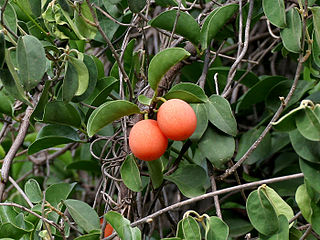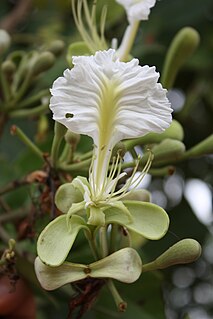
The Annonaceae are a family of flowering plants consisting of trees, shrubs, or rarely lianas commonly known as the custard apple family or soursop family. With 108 accepted genera and about 2400 known species, it is the largest family in the Magnoliales. Several genera produce edible fruit, most notably Annona, Anonidium, Asimina, Rollinia, and Uvaria. Its type genus is Annona. The family is concentrated in the tropics, with few species found in temperate regions. About 900 species are Neotropical, 450 are Afrotropical, and the remaining are Indomalayan.

Houttuynia cordata, also known as fish mint, fish leaf, rainbow plant, chameleon plant, heart leaf, fish wort, or Chinese lizard tail, is one of two species in the genus Houttuynia. It is a flowering plant native to Southeast Asia. It grows in moist, shady locations. It was named after Martinus Houttuyn.

Monodora myristica, the calabash nutmeg, is a tropical tree of the family Annonaceae or custard apple family of flowering plants. It is native to Angola, Benin, Cameroon, the Central African Republic, the Democratic Republic of the Congo, Equatorial Guinea, Gabon, Ghana, Guinea-Bissau, Ivory Coast, Kenya, Liberia, Nigeria, the Republic of the Congo, Sierra Leone, Sudan, Tanzania, Togo and Uganda. In former times, its seeds were widely sold as an inexpensive nutmeg substitute. This is now less common outside its region of production. Other names of calabash nutmeg include Jamaican nutmeg, African nutmeg, ehuru, ariwo, awerewa, ehiri, airama, African orchid nutmeg, muscadier de Calabash and lubushi.

Xylopia africana is a species of plant in the Annonaceae family. It is found in west-central Africa. It is restricted to submontane and lower montane forests. It is threatened due to habitat loss by clearance of forest. It was first described as Melodorum africanum in 1862 by George Bentham.

Ximenia americana, commonly known as tallow wood, hog plum, yellow plum, sea lemon, or pi'ut (Chamorro), is bush-forming shrub/small tree; a species from the Ximenia genus in the Olacaceae family. It is commonly found in woodlands native to the tropics in Africa, Asia, America and Australia, and grows to a height of 7m. Its leaves are borne on spur shoots and have a spear-like to oval shape. The flowers and fruit of X. americana are aromatic and small. Flowering mainly occurs during the dry season, however, the maturing and ripening of the flowers and fruits occur throughout the year and are not affected by climatic conditions.

Annona senegalensis, commonly known as African custard-apple, wild custard apple, wild soursop, sunkungo, and dorgot is a species of flowering plant in the custard apple family, Annonaceae. The specific epithet, senegalensis, translates to mean "of Senegal", the country where the type specimen was collected.
Hydnocarpus wightianus or chaulmoogra is a tree in the Achariaceae family. Hydnocarpus wightiana seed oil has been widely used in traditional Indian medicine, especially in Ayurveda, and in Chinese traditional medicine for the treatment of leprosy. It entered early Western medicine in the nineteenth century before the era of sulfonamides and other antibiotics for the treatment of several skin diseases and leprosy. The oil was prescribed for leprosy as a mixture suspended in gum or as an emulsion.

Eryngium planum, the blue eryngo or flat sea holly, is a species of flowering plant in the family Apiaceae, native to the area that includes central and southeastern Europe and central Asia. It is an herbaceous perennial thistle growing to 50 cm (20 in) with branched silvery-blue stems, and numerous small blue conical flowerheads surrounded by spiky bracts in summer.

Haumania liebrechtsiana is a species of plant in the family Marantaceae. It grows as an understorey herb or climber in tropical forests in Central Africa. The leaves and shoots are eaten by gorillas and chimpanzees, and the leaves and stems have traditional uses.
Oxandra lanceolata is a species of plant in the Annonaceae family. It occurs naturally in Mexico, Cuba, Jamaica, Haiti, the Dominican Republic and Puerto Rico.
Xylopia acutiflora (Dunal.) A. Rich is a small tree that grows up to 15 m high, it belongs to the Annonaceae family.
Xylopia staudtii Engl & Diels is a tall tree within the Annonaceae family, it can grow up to 50 meters tall, the tallest height of the African Xylopia trees. It occurs in forest and freshwater swamps in West Africa.

Annickia chlorantha is a tree that grows up to 25 meters tall, it belongs to the Annonaceae family. An important tree used in traditional medical practices for the treatment of malaria and various diseases in Nigeria and Cameroon; oil extracted from stem barks and leaves of the species and Annickia affinis, its more common close kin have been widely studied.
Duguetia staudtii is a medium-sized evergreen tree within the Annonaceae family. Species is one of four within the genus Duguetia that is native to Africa.
Annickia polycarpa is a small to medium-sized tree found in evergreen forests of West and Central Africa, it is within the Annonaceae family. It is also called the African Yellow wood.
Gardenia imperialis is a small to medium sized tree within the Rubiaceae family, it is found in swamp savannahs or forests in Tropical Africa.
Lannea microcarpa is a dioecious plant within the Anacardiaceae family. It is also called African grapes and occurs in the Sudan and Guinea savanna of West Africa from Senegal to Cameroon. The plant is used to dye basilan fini, a traditional cloth in a red and brown colour.

Berlinia grandiflora is a small to medium sized three found in the West and West Central African region along riparian habitats or gallery forests habitat types.
Mammea africana is a medium to large sized tree within the family Calophyllaceae, it is also known as African mammee apple and its timber is traded under the trade name, Oboto. Mammea africana is found in evergreen and semi deciduous forests in West and Central Tropical Africa.
Entandrophragma angolense is a tree species with alternate, pinnately compound leaves that are clustered at the ends of branches. It is within the family Meliaceae and has a wide distribution area, occurring in moist semi-deciduous and evergreen forest regions of Tropical Africa from Sierra Leone to Uganda.









